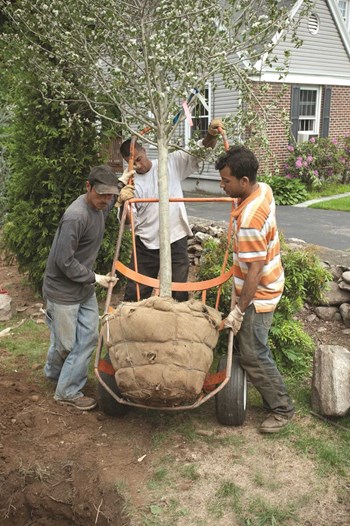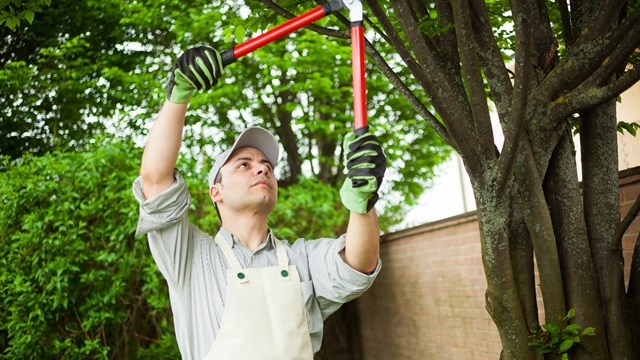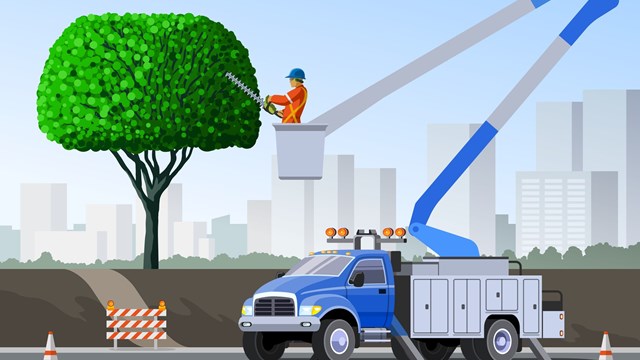
A century ago, Joyce Kilmer penned, “I think that I shall never see a poem lovely as a tree.” Today, arborists tell us that how lovely the tree depends on the variety of tree and how and where trees are planted. According to these licensed individuals who help people correctly and efficiently care for trees, condominium associations need to take more care as they plan for tree life around their properties.
Jeff Bourque, ISA Certified Arborist at SavATree in Lincoln, Massachusetts, says that the biggest issue he sees is the wrong tree in the wrong place. For example, he explains that fruit trees are a popular choice for condominium properties, but “fruit trees can be messy over parking areas and walkways and can present a hazard as they age.” Richard Grant, an arborist with Mayer Tree Service Inc. in Essex, Massachusetts, adds, “Bradford Pears have been planted widely in communities, but pear trees grow fast, become weak and break in heavy snow and wind.”
Adam Cervin, district manager of the Hamden and Stamford, Connecticut, offices of The Care of Trees, a Davey Company, says that in his experience developers do not adequately take into account the root zones of trees — the underground space trees need for their roots for ideal growth. “Developers want instant curb appeal and choose trees of certain size to achieve that goal, and then the trees become too large too quickly. The trees are also planted too close together, surrounded by concrete and sidewalks which do not allow for an ideal root zone.” Jason Yerke, arborist and owner of Distinctive Tree Care in South Windsor, Connecticut, agrees and expands, “Before 2000, developers planted too many trees in a given area, close to roads, buildings, and walkways, and they also planted poor quality species such as White Pines, Norway Maples, and Crabapples. After 2000, the main problem has been with planting techniques. We see ‘mulch volcanoes’ around the base of young trees, which creates a poor environment for these trees to grow in. They create a ‘girdling root’ environment around the base of the tree which can slowly choke, weaken and eventually kill the tree.”
Diversity is Key
So, what should condominium associations know as they consider the trees around their property? The professionals all agree that when it comes to trees, insects and disease should never be left out of the equation. “The key to avoiding a catastrophic loss due to insect or disease is diversity,” says Bourque. “A monoculture, like the abundance of maples around Worcester, allows a pest like the Asian Long-horned Beetle to thrive. Select trees that are varied to reduce this type of threat. The mixed evergreen hedge or border planting is becoming very popular and is sensible. There are also several varieties of disease resistant trees, such as the hybrid elms that are immune to Dutch Elm disease or crabapples that are resistant to fire blight and rust.”
Grant recommends planting non-host species of trees to avoid Asian Long-Horned Beetle “which has wiped all host species.” Yerke explains that in Connecticut, “We tend to favor using improved native species or hybrids.” He adds that there are 30 species of trees to choose from that are “the result of selecting trees because of their proven results (durability and hardiness), availability, and pricing.” Cervin advocates taking maintenance into account before choosing a tree. “Certain trees get routine pests and need treatment every single year, so associations might not want to plant those trees. For example, hemlock trees get the Hemlock Woolly Adelgid, which is a piercing, sucking insect and looks like a white small cottony mass on twigs. Another is the White Birch which people love, but they get the Birch Leaf Miner, which tunnels between the upper and lower leaf surface, creating brown turpentine tunnels within leaves, and the Bronze Birch Borer insect that tunnels into the trunk system and kills the trees.”
Spray It
What should condominium associations do, though, if they have already-planted-trees which are susceptible to insects and disease? Grant suggests using spray programs. “Regular spray programs help associations keep an eye on the trees and keep insect populations down.” Cervin advocates bringing in an arborist to assess the condition of the trees and any level of infestations. “Then,” he says, “associations will be able receive a recommendation for removal or not of trees. If a tree can’t be saved, or it’s not cost-effective to save the tree, or it’s a safety issue, the tree should be removed. If the tree is salvageable, there are general treatments to keep and increase the vigor of the tree and to treat for pests.”
If trees do need to be removed, Bourque recommends that condominium associations consider pertinent questions before replanting. He says, “Depending on the needs of the landscape or wants of the owners, there is a suitable tree for almost any landscape situation. Decide what is most important: Do you want shade or lots of sun? Do you want smaller trees? Trees with flowers? Think about the conditions: Is the planting site sunny or shady? How is the soil drainage? Will surface roots be a problem?”
“And do not forget to plan for maintenance,” says Yerke. “The attention associations pay to their trees is all over the place. The associations that budget for tree work are always in the best shape. We walk through a condo property on a yearly basis and plan a certain amount of work. This plan is based on money available and priorities for the board.” As Yerke explains, “The first step is for the condo association to isolate and attend to safety issues as its first priority which includes dead trees, dead branches, and line of sight obstructions. From there, the association can then plan a certain amount each year to be used proactively to prune or repair trees. Trees are always an issue and can’t been dealt with on an as-needed basis.”
In fact, when it comes to regular maintenance of trees for condominium properties, the pros all strongly advocate being proactive instead of reactive. As Bourque explains, “Most associations will have a landscape budget for the basics like mowing and cleanups, but they should also figure a budget for tree care and maintenance. If a condo association has many older or dying trees, start planning now for pruning and/or replacements, and buffer the cost by doing the work in phases. Target specific areas of the landscape, or just tackle the worst of the worst, and budget accordingly.” Cervin agrees and adds, “It’s important to develop a partnership to help manage trees. Find someone with a good track record and reputation and plan for ongoing work and help to prioritize for overall care and not just symptom approach. In the warmer seasons, associations need to monitor for insects and pests and general plant health, doing fertilization and soil testing and monitoring irrigation and for pests. In the winter is when tree removals should be done because the trees are more dormant with less mass, and there will be less damage done when the ground is firmer.”
“And don’t forget a regular pruning schedule,” says Yerke. “I am a huge proponent of reducing the lengths of branches. We call this reducing or ‘tipping back.’ White Pines, for example, can extend their branches 20-30 feet from the trunk. Once the tree reaches 15-20 feet wide, with any snow or ice, these branches will often snap and fall. Besides the hazard of this to anything below, the tree usually loses a section of itself. This often means loss of privacy or aesthetics.” Grant concurs and expands, “Trees should be pruned every three to five years. In a large community we break the area into three to five sections to span the time it will take to begin the process again. This helps maintain their size, shape and health as well as maintaining safety and building clearance.”
If condominium associations are interested in lower maintenance trees to keep costs down, Yerke offers up ornamental trees. “They are 12 to 25 feet for their mature height, which fits well into smaller environments,” he says. “The Kousa Dogwood Tree from Korea has a cream yellow flower in summer and gets very few insects and diseases. Another is the Stewartia which also has a yellow cream flower, and it’s very uncommon for it to have insect and disease issues.” Grant says, “Oaks (because they are strong), disease resistant crab apples (if people want a fruit tree), Hackberries, Sweet Gums and Filberts are all nice, too.”
Bourque advocates strong trees. “Norway Spruce, Pin Oak, White Oak, Beech, and London Plane tree are a few good shade trees that have the least amount of storm damage issues in my experience. These are trees that generally have a good natural structure and/or very strong wood.” And Yerke’s advice? “Plant newer hybrid varieties.”
In the end, the experts all advocate that proper tree selection and proper planting of the trees selected with a maintenance plan in place are the best ways to ensure that condominium associations “shall never see a poem as lovely as a tree.”
Paula Castner is a freelance writer and a frequent contributor to New England Condominium.






Leave a Comment